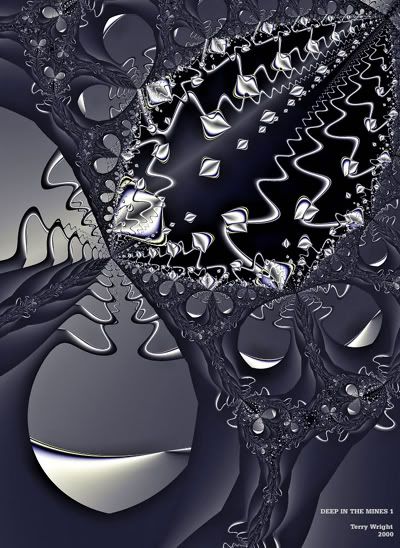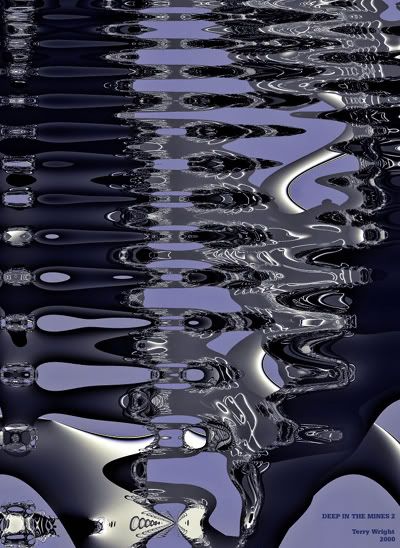Deep in the Mines
Deep in the Mines 1 (2000)
Fractals sometimes transcend their parameters. If they are art -- and I'm guessing that most of us think they are -- then our images reflect some deeper part of ourselves. Our dreams. Our buried treasures.
Tina got me thinking about this standing on the shoulders of giants business. It's true that someone built the mine by writing a program or a formula. But the artist still has to take that journey to the underworld and cart back the gold or silver.
It's a dangerous business. Rooting around under the surface for meaning. Sometimes you strike it rich. Other times what you find blows up in your face.
And there's no drop dead canary telling you when your image glitters or smells like gas.
Deep in the Mines 2 (2000)
I've often used the word spelunking to describe my artistic process. I crawl through images -- hauling out dirt, clearing a path to see what still lies ahead. It can be claustrophobic. Sometimes I chip away at one delicate section for hours. Sometimes I thrash around blindly. Even a cave-in is better than finding nothing.
Maybe someone caved or carved out parts of this mine before me. But I'm still the one who has to go down there -- again -- alone -- in the dark.
The classics are filled with treacherous journeys to the underworld where ghosts linger and are haunted by their memories of life. Maybe, like Orpheus, my images will sing, and I'll return to the light with something I love. Unless I get impatient. Unless I turn around to look at what I've made before the trip is finished. We've read the story. We know what happens then.
I think fractals can reveal memories from the substratum. They flock around Odysseus at the pit of blood. If you risk going underground, they might settle around you like leaves encircling a tree. Or they might mock you from the safety of the shadows.
They are more than "the cold equations" of Tom Godwin's moving story. They are like engrams. Brain scans anyone can read.
There's plenty of uranium deep in the mines. With it, you can see inside yourself.
And see through others, too.
Deep in the Mines 3 (2000)
Mine.
Mind?
Dig still deeper...
Deep in the Mines 4 (2000)
Sometimes I wake up in the middle of the night. I have bits of poems or images partially unburied in my head. I've learned to get up immediately and start shoveling with my pen or keyboard. If I don't, those whispers from the Muse will vanish like Eurydice.
Here's something I wrote in my notebook several years ago in a semi-sleepwalk:
The mine
is darker than
the last thing you
said
to me
ten years ago
today.
Someone probably said something similar before me. Maybe I should have left this lump of coal resting under tons of rock.
But we don't, do we? We open our notebooks and our programs -- and, with dim light pouring from our foreheads, we start digging.
And, sometimes, if we persevere and are lucky, we uncover something.
A nugget pick-axed out of the ore.
A diamond hewn from the darkness of the subconscious.
Rare chunks of art hauled out from deep in the mines into the open air for all to see.








2 Comments:
I find the mythologies from antiquity possess a unique charm, and like to reflect that at one time, many were taken seriously by people as religions, but that the modern religions haven't squelched them. They continue to exist as stories and fables, and have found their "natural" home.
About the midnight inspiration, there was a chess master named Frank Marshall who used to take a board and pieces to bed with him to try out right away any plays he might dream up. One he discovered has gone down in the literature as the Marshall Attack. It was unsuccessful in its first appearance, but scores of players have tried it since with varying results. For many years, thought to be unsound, the current thinking is that it's good enough for at least a draw.
12/29/2006 2:25 PM
I have very much enjoyed this visit to your site. Thank you for sharing what you find beautiful in fractals.
1/28/2007 7:45 PM
Post a Comment
<< Home